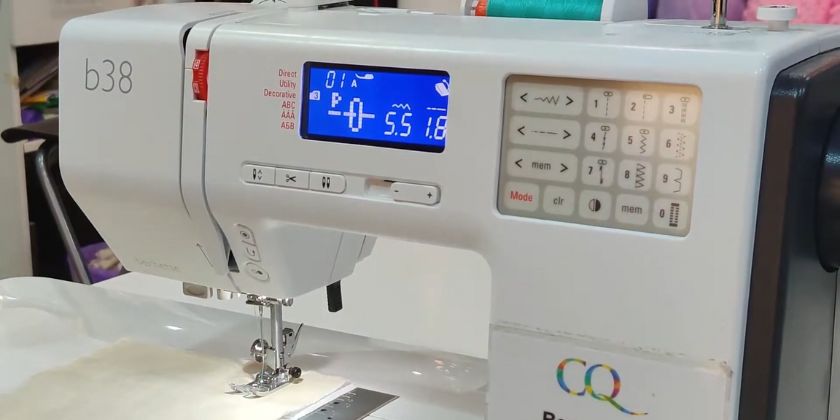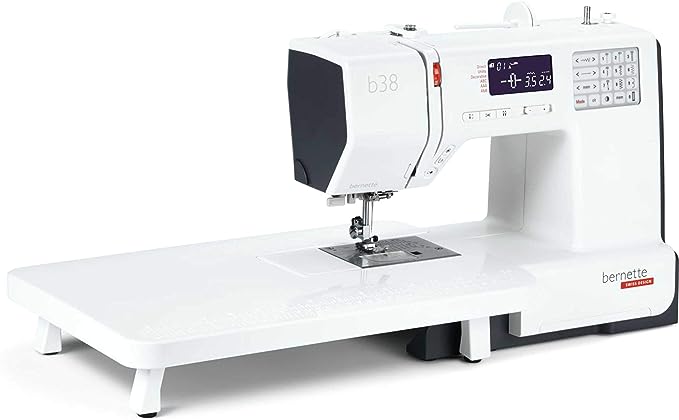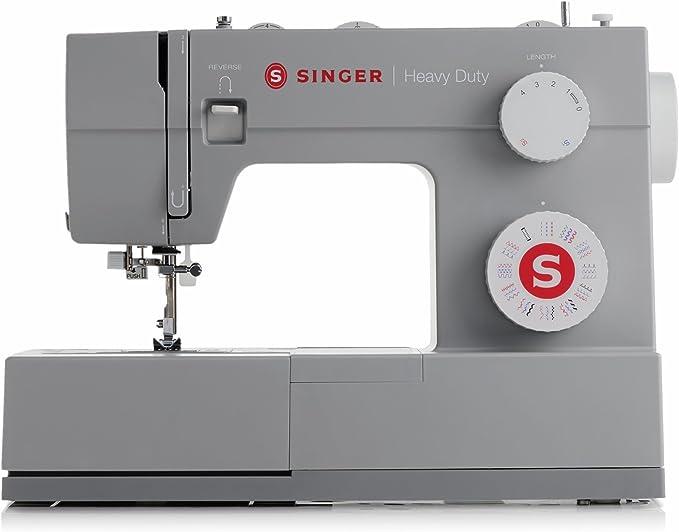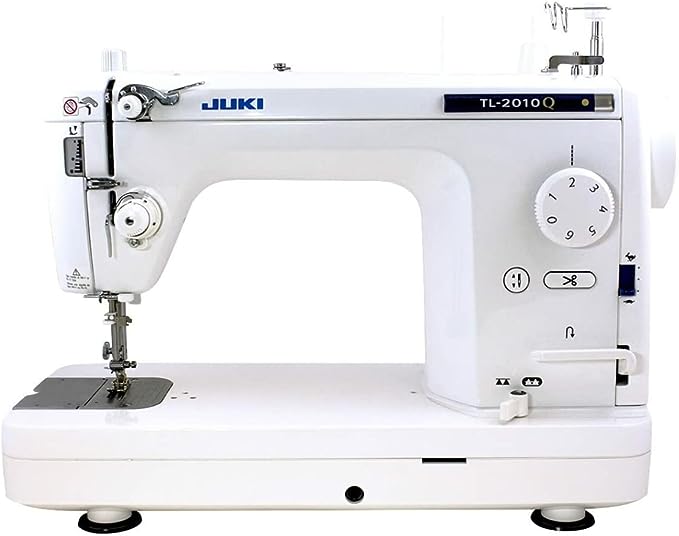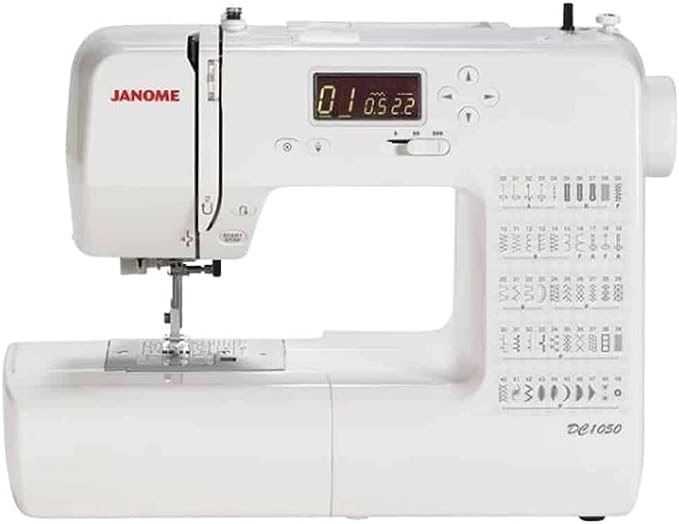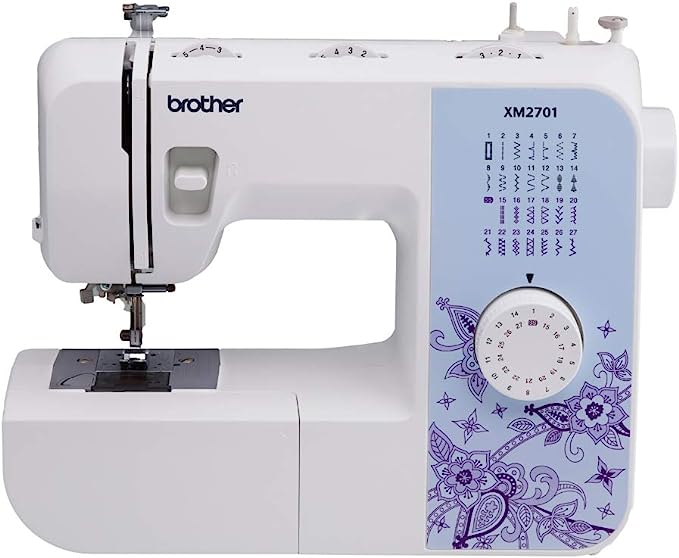I spent 86 hours testing out dozens of sewing machines on all types of denim, from lightweight chambray to thick, heavyweight fabric. After countless stitches and hours of research, I came to a clear favorite: the Bernette 38. It wasn’t just good for denim, it absolutely excelled, handling thick layers and tricky corners with ease.
But fear not, denim enthusiasts of all budgets and experience levels! This guide will explore not just the Bernette 38, but also the perfect machines for budget-conscious sewists and those looking for an industrial powerhouse.
I’m a passionate sewist who’s tackled denim projects of all varieties, from simple repairs to intricate crafts. When evaluating these machines, I prioritized smooth stitching through thick layers, ease of use, and features specifically helpful for denim projects. However, I understand that every sewer has unique needs. So, whether you’re a seasoned pro or just starting your denim journey, keep reading to find the perfect machine for you!
Top 5 Best Sewing Machines For Denim – Tested & Reviewed
- Top 5 Best Sewing Machines For Denim – Tested & Reviewed
- #1. Bernette 38 – Best Sewing Machine For Denim And Leather
- #2. Singer 4432 – Best Budget Sewing Machine for Denim
- 3. Juki 2010q – Best Industrial Sewing Machine For Denim
- 4. Janome DC1050 – Best sewing machine for denim and jeans
- 5. Brother XM2701 – Another Best sewing machine for denim pants
- Do You Need a Special Sewing Machine For Denim?
- Do You Use High or Low-Tension When Sewing Denim?
- How Do You Set Up a Sewing Machine For Denim?
- How Much Does a Good Sewing Machine For Denim Cost?
- What Type of Thread should I use for denim?
- Which Stitch is Best for Denim?
- What Should I Consider In A Sewing Machine For Denim?
#1. Bernette 38 – Best Sewing Machine For Denim And Leather
Best Pick
- 7mm stitch width
- 820 stitches/minute speed
- 394 stitch patterns
- 21.75 lbs weight
This computerized sewing machine is the top model from the Bernette 30 series.
With 394 different patterns, eight 1-step buttonholes, and three alphabets, you can easily design everything from stylish T-shirts to intricate cutoff jeans with this machine.
It also provides maximum sewing flexibility with eight included presser feet – like the zigzag foot, the satin foot, and the buttonhole foot – to give you the perfect stitch quality for any material.
You also get the option to adjust the presser foot pressure to suit light and thin fabrics. To make sewing large projects like curtains or quilts easy and hassle-free, the Bernette 38 comes with an extension table for extra space.
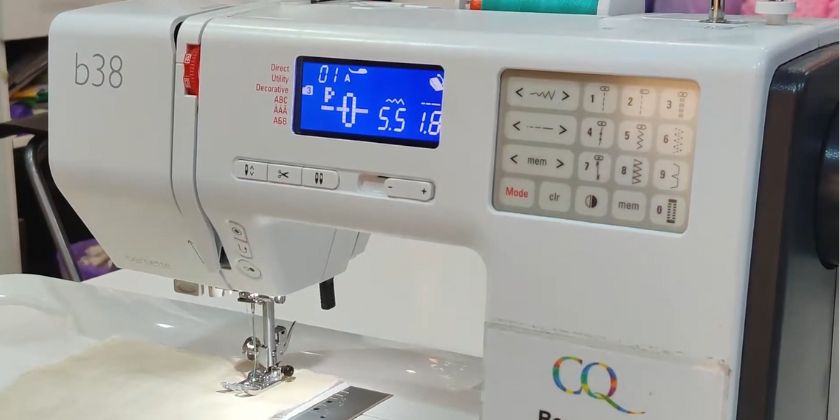
And, if that’s not enough, the Bernette 38 also features a double-needle safety function, which limits the stitch width so that the needles don’t touch the presser foot.
One of the best features I likes about this sewing machine is the fantastic tie-off and cutting functions. When you’re finished with a seam, the automatic tie-off feature securely ties it off, so you don’t have the need to make a quick backward+forward stitch at the end.
It weighs only 21.75 lbs and is a computerized sewing machine, making many wonder whether it can sew denim.
Believe it or not, it is. During my time with this machine, I was able to sew 3-4 layers of denim with it without any issues.
These amazing features and excellent performance make Bernette 38 the overall best sewing machine for denim.
Pros and Cons
Pros:
- Lightweight and portable.
- Quiet operations.
- Detailed instruction manual.
- 10-year limited warranty.
Cons:
- Has a slight learning curve, especially for beginners.
- Moderate sewing speed.
#2. Singer 4432 – Best Budget Sewing Machine for Denim
Budget Pick
- 5mm stitch width
- 110 stitch applications
- 1100 stitches/minute speed
- 25-year warranty
The Singer 4432 is another budget Sewing Machine I tested last year.
In case you’ve noticed closely, the Bernett 38 is labeled by Bernina as a budget sewing machine. But that’s only in comparison to the other Berinna flagship sewing machines.
Compared to most other sewing machines, it’s a premium product.
Therefore, if you want a truly budget sewing machine for denim, there’s Singer 4432 for you. It’s almost three times cheaper than the Bernett 38 but has nearly all the features you expect in a sewing machine.
The automatic needle threader will have you threading your needle fast and effectively, with no need to strain your eyesight. The top drop-in bobbin ensures you can quickly and easily insert and monitor the bobbin thread supply. You can switch the drop feed lever to disengage the feed dogs for free-motion sewing.
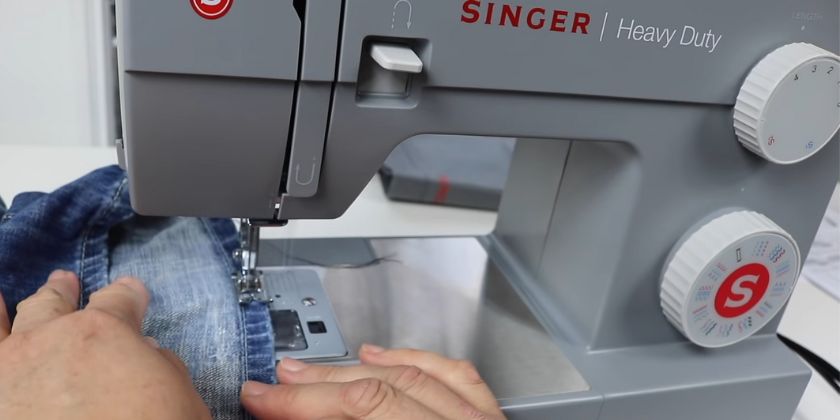
You’ll also appreciate the adjustable stitch width of up to 6mm, providing great decorative and satin stitching options. Its free arm allows you to easily sew collars, pant hems, and other narrow areas, ensuring you get a professional finish every time.
With 110 stitch applications, Singer 4432 is the sewing machine for everyone who loves crafting clothes, home decorations, and much more.
Other features include a 1-step buttonhole, snap-on presser feet, and adjustable presser foot pressure control.
Lastly, it boasts a heavy-duty metal interior frame, a stainless steel bedplate, and a high speed of up to 1100 stitches per minute.
Pros and Cons
Pros:
- Sturdy despite being lightweight
- Easy to use
- Powerful motor
- 25-year warranty
Cons:
- The user manual is not as detailed as we would’ve liked.
- Can’t perform heavy-duty tasks for an extended period.
Related Post – The 5 Best Sewing Machines For Auto Upholstery
3. Juki 2010q – Best Industrial Sewing Machine For Denim
Upgrade Pick
- 8 1/2-inch throat
- 6mm stitch length
- 1500 stitches/minute speed
- L-shaped bobbin type
If budget is not a concern and you want an industrial-grade sewing machine to sew denim, then I would recommends you to go with Juki 2010q.
With industrial-grade aluminum die-casting for its arm and bed, this machine is sure to last.
It features a large work area of up to 23 inches, ensuring you can easily tackle large quilts, sewing projects, and home decor.
It also makes thread replacing a breeze with its bobbin latch and enlarged bobbin case area. With the needle up/down button, you can quickly move your needle as desired with one button press, even stitching stitch by stitch at a low speed.
Another great feature of the TL-2010Q is the push lever automatic needle threader. Say goodbye to frustrating eyestrain and enjoy the painless ease of threading.
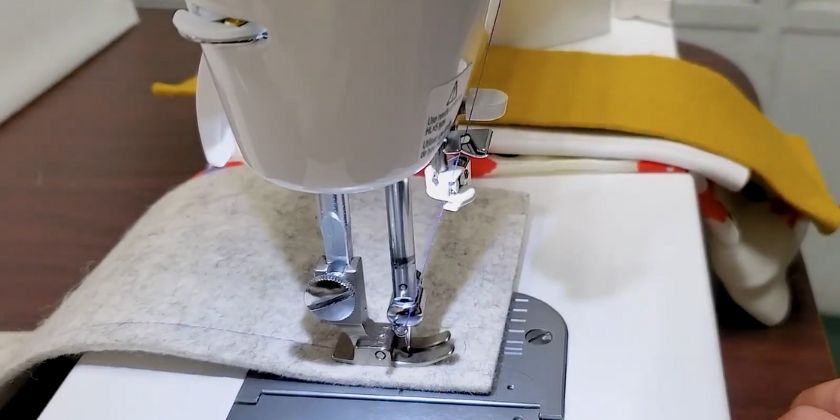
The adjustable pressure foot allows you to customize the presser foot pressure depending on the fabric you’re working with, while the quilting feet are designed for free-motion quilting and embroidery.
And when you need some extra room during quilting, the feed dog can be easily raised and lowered with just a switch.
With the built-in knee lifter lever, you can lift or lower the presser foot without effort. This proves particularly helpful when working on light to heavy-weight materials.
To ensure the best results, the TL-2010Q includes a thread tension scale, allowing you to accurately select the right amount for the specific thread and material.
Pros and Cons
Pros:
- The stitch quality is excellent for all types of fabric, light or heavy.
- Changing the tension is surprisingly simple.
- Snappy needle-threading
- LED lights are a great add-on for illuminating the workspace.
Cons:
- The needle threader can be difficult to use.
- Plastic pieces on the machine can break easily if not handled properly.
4. Janome DC1050 – Best sewing machine for denim and jeans
- 50 stitches
- 5mm stitch length
- 820 stitches/minute speed
- 7mm stitch width
The Janome DC1050 is another top-of-the-line sewing machine offering everything an experienced sewer needs for denim.
With fifty built-in stitches and a plethora of stitch patterns, the Janome DC1050 gives you flexibility and creativity like no other sewing machine.
From basic, straight, zigzag, stretch stitch, and blind hem stitches to more intricate embroidery and heirloom stitches commonly used on wedding gowns and veils, you’ll have all the tools to create stunning projects.
The maximum length of these stitches is up to 5 mm, and the maximum width is 7 mm. And because they’re printed directly on the machine, you’ll spend less time searching for the right one and more time stitching.
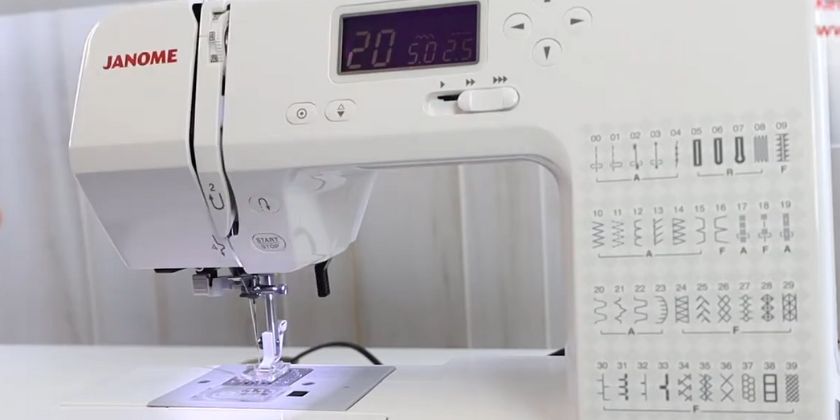
For extra convenience, the presser foot of the Janome DC1050 is adjustable and slides on instead of snapping in.
Plus, the machine is compatible with presser feet from other Janome models, so it’s easy to switch over. It has four presser feet to get you started: standard, zipper, zigzag, satin, and automatic buttonhole.
This DC1050 sewing machine features an automatic tension setting system, so you can adjust your needle placement exactly where you want it—down to the millimeter.
The LCD screen displays all your adjustments, like the stitch pattern, length, and width. Plus, with the button-controlled start function, you can control the machine without needing a foot pedal.
Other features include a free arm for hard-to-reach places on garments like sleeves and cuffs, automatic declutch bobbin winding, and a one-handed needle threader,
The Janome DC1050 also features top-loading, full rotary hook bobbins, so you can quickly see how much thread remains in the bobbin through the window.
Pros and Cons
Pros:
- Easy to operate
- Drop-in, top-loading bobbin
- Good value for money
- Quite operations
Cons:
- LED light is a little too dim for some people
- Can’t sew multiple fabric layers
5. Brother XM2701 – Another Best sewing machine for denim pants
- 27 built-in stitches
- 800 stitches per month
- 4mm stitch length
- 5mm stitch width
- 25-year warranty
The last sewing machine I tested is the Brother XM2701.
It features 27 unique built-in stitches and 63 stitch functions, with an outstanding automatic needle threader for easy thread changes.
An illuminated LED work area ensures you can work during the night time.
The Brother XM2701 includes a selection of 6 presser feet – the Zigzag Foot, Buttonhole Foot, Button Sewing Foot, Zipper Foot, Narrow Hem Foot, and Blind Stitch Foot – that are capable of executing a range of sewing projects and specialized techniques.
Furthermore, the included automatic one-step buttonholer allows you to sew perfect buttonholes quickly and easily in one step.
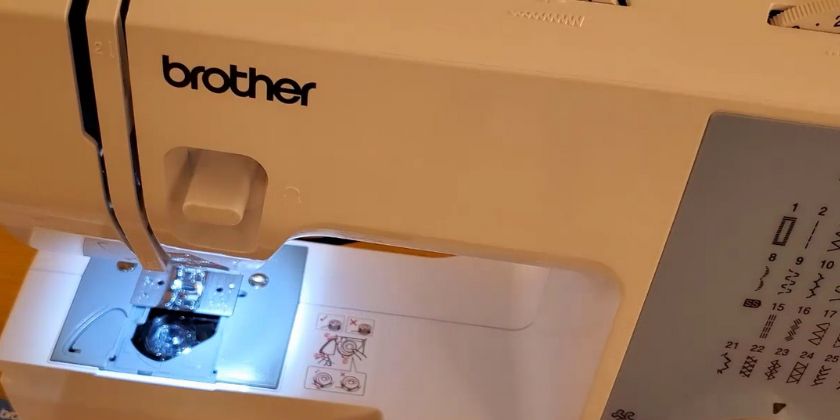
The bobbin winding system on the top of the machine is incredibly convenient, along with the top-drop, quick-set bobbin.
Threading the needle is also a breeze, thanks to the helpful instructions with your purchase and the numbers imprinted on the machine to jog your memory.
Plus, you won’t ever have to worry about running out of thread mid-project, as the bobbin case is transparent, so you can easily keep an eye on how much thread you have left.
For those new to sewing, the XM2701 has an instructional DVD to help you get started.
If you’re looking for an affordable, reliable sewing machine, the Brother XM2701 is an excellent choice. It offers an impressive range of features for a reasonable price point, and Brother gives you a 25-year limited warranty + online support.
Pros and Cons
Pros:
- Beginner-friendly
- Lightweight
- Affordable price
Cons:
- Slightly noisy
- LED light could’ve been a little brighter
Do You Need a Special Sewing Machine For Denim?
Denim is generally a thicker material than most other fabrics used in clothing, which makes it more challenging to sew.
Industrial-grade heavy-duty sewing machines can handle larger amounts of fabric faster than their standard counterparts.
They use stronger needles that won’t bend easily when faced with heavy materials like denim and higher-powered motors that keep going without feeling bogged down by too much bulk flowing through the needle plate area.
They also have an adjustable presser foot pressure option on board, so you can adjust this setting based on your task at any given time.
Do You Use High or Low-Tension When Sewing Denim?
Adjusting the tension can make all the difference in achieving professional-looking results depending on the fabric you are working with and the stitching size.
When sewing denim, you should generally use a low-tension setting on your machine, allowing heavier fabrics like denim to pass through more efficiently while still producing tight stitches.
However, there are certain circumstances where high-tension settings may be necessary.
For example, if you’re working with thicker denim that’s densely woven or multiple layers of fabric that need extra reinforcement from stronger stitches—you may want to consider using higher tensions instead.
On most machines, this will involve turning up your upper thread tensions beyond their usual settings for maximum hold and durability of stitches throughout the garment’s lifetime.
For more information, check out this thread tension chart.
How Do You Set Up a Sewing Machine For Denim?
Setting up a sewing machine for denim can seem daunting, but it’s pretty simple with the right tools and knowledge. To get started, here are the steps you’ll need to take:
- Choose the Right Needle and Thread – Make sure your needle is size 90/14 or 100/16 to accommodate the thickness of denim fabric and use a universal thread that has good durability. Remember that regular polyester thread will work for lighter fabrics like cotton. Still, when using thicker materials such as denim, you’ll need a strong thread such as bonded nylon or Teflon-coated polyester so it won’t break during sewing.
- Select an Appropriate Stitch Length – Denim is a thick material requiring longer stitch lengths than thinner fabrics; try starting with 3mm or 4mm for best results. Also, remember that some machines may have difficulty stitching over multiple layers of a heavy material; if so, use one layer at a time by folding the denim in half before feeding it into your machine.
- Set Your Presser Foot Pressure – This should generally be higher than usual since heavier-weight material requires more pressure to feed through correctly; consult your manual to determine what works best for your specific machine model (or ask an expert if needed). Most machines offer adjustable presser foot pressure settings from 1-5: Start off on 3 and gradually increase until you find the best setting.
- Adjust Tension Knob Settings – For soft materials like cotton twill, adjust the tension knob to midpoint settings (7), whereas thicker fabrics require lower tension knob settings(4-5). Again, this setting will vary depending on the fabric’s thickness, so consult with an expert if needed.
- Test on Scrap Fabric – Once everything looks good, test out your stitching setup by running some scrap fabric through before moving on to actual pieces of clothing or projects being made. This way, you can make any last-minute tweaks necessary until desired results are achieved.
How Much Does a Good Sewing Machine For Denim Cost?
The cost of a good sewing machine for denim depends on the type and quality of the machine you want to purchase.
Generally, high-end industrial machines with multiple attachments can cost between $1,000 – $2,500 or more, depending on your chosen features.
Mid-range sewing machines with essential adjustable functions and accessories typically range in price from $400 to $800.
If you’re starting out and need something simple, beginner sewing machines for denim are available for as little as $100 -$200, allowing you to create basic projects like patches or repairs.
What Type of Thread should I use for denim?
When it comes to sewing denim, you want to find a type of thread that is strong and durable so that your denim project will last.
The best kind of thread for working with denim is the polyester-wrapped core-spun thread. It has a polyester wrapped around the cotton core, making it much stronger than regular all-cotton threads.
It also has a high tensile strength and can withstand the stress of working with thick fabrics such as jeans or jackets made from heavy-duty denim.
Because this kind of thread is very strong, there’s no need to worry about breakage when stitching on heavier fabrics like denim; this makes it ideal for hemming jeans, creating straps or belts for jackets, etc.
Furthermore, polyester-wrapped core-spun thread doesn’t shrink or lose color in response to water and won’t fray like many other threads, thus ensuring that your project looks good even after multiple washes.
The strands are also resistant to abrasion, which makes them perfect for topstitching seams and doing intricate embroidery projects on thicker layers without worrying about fraying edges on the fabric surface.
Which Stitch is Best for Denim?
The best stitch type for denim depends on the fabric thickness. Generally speaking, you should use straight stitching with a length of 3.0 mm to 4.0 mm and increase your sewing machine’s tension to 4.6 (up from 4.0 for lightweight woven fabrics).
A straight stitch is considered more secure because it interlocks both sides of the top thread into a single place in the fabric below, unlike zigzag stitches, which “encase” the upper thread more loosely, creating a looser bond between two threads.
That being said, there are specific applications where zigzag stitches can be stronger than straight ones, such as when using heavy fabrics that require additional strength or when an application calls for a stretching or gathering effect that requires elasticity – think stretchy knitwear made out of cotton-lycra blends.
What Should I Consider In A Sewing Machine For Denim?
Below are a few factors you need to consider when choosing a sewing machine for denim.
Dedicated Denim Needle:
A dedicated denim needle is absolutely paramount when it comes to sewing denim. Due to its thickness and heavy weight, denim requires a robust and sharp needle to penetrate multiple layers without breaking.
A standard sewing needle is typically unable to meet this demand and might result in uneven stitches or cause damage to your machine.
Therefore, investing in a denim needle that handles heavy, tightly woven fabrics like denim is a wise and essential choice. These needles come in different sizes, so be sure to choose one suitable for the thickness of your denim fabric.
Remember, a correctly chosen needle can make a significant difference in the quality of your sewing and, in this case, can simplify the demanding task of sewing denim.
Presser Foot
The Presser Foot is an integral component of your sewing machine that holds the fabric firmly in place as you sew, ensuring consistent stitching.
It exerts pressure on the material, preventing it from moving or shifting under the needle. This is especially crucial when working with denser fabrics like denim, as it helps maintain control and prevents uneven stitches or fabric bunching.
Generally, the roller foot and walking foot are the two preferred presser feet for sewing denim.
Roller foot
The Roller Foot is a specialized type of presser foot designed for sewing heavy and textured materials such as denim. It features small rollers that facilitate smooth movement over the fabric.
These rollers reduce friction, allowing the foot to glide effortlessly over the material, resulting in even and precise stitches. The roller foot is particularly beneficial when sewing through multiple layers of denim, ensuring smooth and consistent sewing without any fabric distortion.
Walking foot
Lastly, the Walking Foot, also known as a “dual feed foot,” is another essential tool for sewing denim. This foot has its own set of feed dogs (teeth that move the fabric through the machine), which work in synchronization with the machine’s existing feed dogs.
The walking foot evenly feeds both layers of material through the machine, preventing shifting or misalignment. This is especially useful when sewing multiple layers of denim, as it ensures that the layers stay together and do not separate during the sewing process.
The walking foot helps achieve precise and uniform stitches, making it an indispensable tool for working with denim fabric.
Powerful Motor and Metal Frame
The motor and frame of your sewing machine are vital components to consider when selecting a machine for denim sewing. A powerful motor will ensure the machine can handle heavy fabrics without jamming or straining, while a metal frame provides stability and durability.
When shopping for a denim sewing machine, look for an adjustable speed setting to adjust the rate depending on the fabric and stitch patterns you are working with. Additionally, ensure that the machine has a built-in bobbin winder so you can quickly reload your bobbins when needed.
Stitch Length Variation
The stitch length setting determines the size of each stitch, and a longer stitch is often preferred for denim to ensure it’s securely sealed.
Therefore, choose a sewing machine with adjustable stitch length settings to choose the ideal one for your project. Additionally, many sewing machines come with built-in stitch patterns such as zigzag and straight stitches.
These options are great for denim sewing, allowing you to create unique designs and patterns easily. Lastly, consider a machine with an automatic thread cutter feature, saving you time when switching between fabrics or colors.
Threads:
When sewing denim, using the correct thread is essential to ensure your stitches are strong and secure. Look for threads specifically designed for heavy fabrics such as jeans or other denim materials.
Denim thread is heavier than regular thread and can handle the pressure of multiple layers of fabric without breaking. Additionally, make sure to choose a thread that matches the color of your denim fabric to create a cohesive look.
